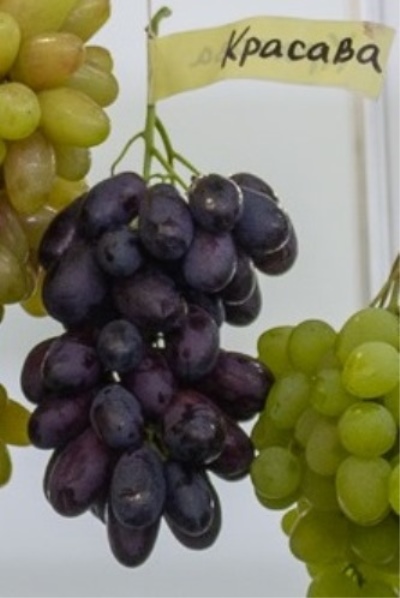
- Authors: Kalugin Viktor Mikhailovich
- Appointment: dining room
- Berry color: dark pink-purple
- Taste: harmonious
- Ripening period: early middle
- Ripening period, days: 115-120
- Frost resistance, ° C: -22
- Bunch weight, g: 800
- Flower type: bisexual
- Density of the bunch: loose
The Krasava grape belongs to the varieties developed in the current decade. But despite this, thanks to its unique qualities, today it is very popular with both breeders and amateur gardeners.
Breeding history
The Krasava table grape variety was bred by the Ukrainian breeder Viktor Mikhailovich Kalugin. Presumably, this variety appeared as a result of crossing the Talisman and Velika varieties. A new form of the hybrid was planted with seeds in 2013, and in 2017 Viktor Mikhailovich harvested the first crop that met his expectations. In 2018, for the second fruiting of the seedling, the breeder managed to get 18 bunches of excellent quality. It is believed that the name of the variety was traditionally invented by guests who visit Kalugin's vineyards.
Description
The Krasava grape is characterized by vigorous bushes. The great vigor of the vine ensures good ripening of the berries. Has bisexual flowers. Each shoot has 2 inflorescences.
Ripening period
Krasava in terms of ripening refers to early-medium varieties. Matures in 115-120 days. In the south of Ukraine and Russia, Krasava ripens in early September. It also ripens well in the northern regions.
Bunches
This variety is characterized by large clusters. Their mass reaches 800 g and more. In shape, the clusters of Krasava are cylindrical-conical and conical. Due to this, the berries do not put pressure on each other and are well ventilated. The bunches are loose, sometimes of medium density.
Berries
The Krasava variety attracts attention with its large berries (12-14 g) of an elongated-oval shape. The fruit is dark pink-purple in color. Coloring starts from the tip of the berry. Krasava grapes are characterized by crispy firm pulp. They stick tightly to the bunch, it is quite difficult to tear them off.
Taste
The Krasava variety belongs to the dining variety. This means that its berries are eaten fresh and have excellent taste. In addition to the harmonious taste of the fruit, this variety has high sugar accumulation rates. The taste of Krasava berries always receives only positive assessments from specialists.
Yield
The variety forms 2 inflorescences per shoot. This is an indicator that Krasava has a good yield. Especially considering the large clusters of these grapes.


Growing features
In general, it is quite easy to grow the Krasava variety. It is unpretentious, does not require special care. It should only be borne in mind that he needs a lot of sunlight.
Landing
On the territory of Russia and Ukraine, Krasava grapes can be planted in any soil. But the soil must definitely warm up.Shoots are planted on the sunny southern side of the site, where there are no drafts and strong winds.

Pollination
The bisexual flowers of the Krasava variety do not require special pollination, in contrast to the female grape varieties. But if desired, additional pollination can be carried out in order to increase the yield or obtain a new variety. For this, grapes of a different female type are planted next to Krasava.
Pruning
In the fall, as part of sanitary pruning, before covering the Krasava bush for the winter, it is necessary to cut out old and sick lashes. Then, for the correct formation of young shoots, pruning is done in the spring. This procedure should be carried out before bud break at a temperature not lower than +10 degrees in sunny weather. In summer, it is recommended to remove stepchildren and thin out the leaves of this variety.

Watering
Watering the Krasava seedling can be done in a simple way using a few plastic bottles. They must be filled with water and buried with their necks down. With this method of irrigation, water flows to the roots gradually, which prevents them from rotting. But it is not recommended to water an adult plant in this way.


Frost resistance and the need for shelter
Despite the fairly good frost resistance of -22 degrees, the Krasava variety requires shelter for the winter. This is especially true for the northern regions. The grape lashes are removed from the support after pruning and carefully laid on the ground. Most often, straw or spruce branches act as a shelter.

Diseases and pests
This variety is quite resistant to diseases and pests. With proper care, Krasava grapes rarely get sick. Sometimes it can be affected by powdery mildew and smallpox. For the prevention of these diseases, it is necessary to treat the plant with copper sulfate at the rate of 5 g of vitriol per 250 g of water; for better adhesion of the solution to the leaves, add a little soap. Brown bumps on the leaves signal a tick infestation. The grapes should be immediately treated with chemicals such as Karbofos or Neoron.

If a grape is exposed to any disease or insect, this always affects its appearance.
Storage
Krasava is well kept, but the grapes are not very transportable. Although strong berries retain their presentation for a long time.











































































